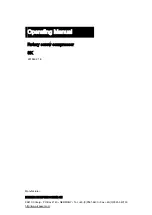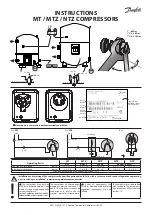
5 - ENG
WARNING
1. Drain the moisture from the tank on a daily basis. A clean, dry tank will help
prevent corrosion.
2. Pull the pressure relief valve ring daily to ensure that the valve is functioning
properly, and to clear the valve of any possible obstructions.
3. To provide proper ventilation for cooling, the compressor must be kept a
minimum of 12 inches (31 cm) from the nearest wall, in a well–ventilated area.
4. To prevent damage to tank and compressor on stationary models, the
tank must be shimmed so the pump base is level within 1/8” to distribute
oil properly. All feet must be supported, shimming where necessary, prior to
attaching to the floor. Fasten all feet to floor. We also recommend the use of
13. The interconnect cord on
this product contains lead, a
chemical known to the State of
California to
cause cancer, and birth defects
or other reproductive harm.
Wash hands
after handling.
NOTE: ELECTRICAL WIRING.
Refer to
the air compressor’s serial label for the
unit’s voltage and amperage requirements.
Ensure that all wiring is done by a licensed
electrician, in accordance with the National
Electrical code.
RISK OF BURSTING.
Air Tank: On February 26, 2002, the U.S. Consumer Product Safety Commission pub-
lished Release # 02-108 concerning air compressor tank safety:
Air compressor receiver tanks do not have an infinite life. Tank life is dependent upon
several factors, some of which include operating conditions, ambient conditions, proper
installations, field modifications, and the level of maintenance. The exact effect of these
factors on air receiver life is difficult to predict.
If proper maintenance procedures are not followed, internal corrosion to the inner wall of
the air receiver tank can cause the air tank to unexpectedly rupture allowing pressurized
air to suddenly and forcefully escape, posing risk of injury to consumers.
Your compressor air tank must be removed from service by the end of the year shown on
your tank warning label.
The following conditions could lead to a weakening of the air tank, and result in a violent
air tank explosion:
WHAT CAN HAPPEN
HOW TO PREVENT IT
• Failure to properly drain condensed water
from air tank, causing rust and thinning of
the steel air tank.
• Drain air tank daily or after each use. If air
tank develops a leak, replace it immediately
with a new air tank or replace the entire
compressor.
• Modifications or attempted repairs to the
air tank.
• Never drill into, weld or make any
modifications to the air tank or its
attachments. Never attempt to repair a
damaged or leaking air tank. Replace with a
new air tank.
• Unauthorized modifications to the safety
valve, or any other components which
control air tank pressure.
• The air tank is designed to withstand
specific operating pressures. Never make
adjustments or parts substitutions to alter the
factory set operating pressures.
DANGER
Содержание PXCMLA4708065
Страница 13: ...13 ENG OPEN CLOSE F E Fig 6...






































